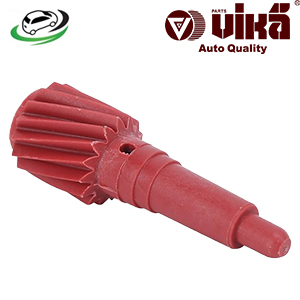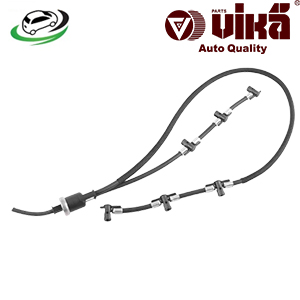-9%
Get Timing Belt AUDI A3 (8L1) / VW Bora I (1J2)/Bora Variant/Caddy II MPV/Golf IV (1J1)/New Beetle (9C1/1C1)/Polo III Classic/Polo IV Saloon 038109119D
The timing belt is a critical component of an internal combustion engine, playing a vital role in synchronizing the engine’s camshaft and crankshaft. This synchronization ensures that the engine’s valves open and close at the correct times during each cylinder’s intake and exhaust strokes. Proper timing is crucial for engine performance, efficiency, and longevity. This comprehensive overview will cover the design, function, importance, types, common issues, and maintenance of the timing belt.
Design and Function
Design:
- Construction:
- Material: Timing belts are typically made from reinforced rubber or synthetic materials, such as neoprene or polyurethane, embedded with fibers like Kevlar or fiberglass for added strength and durability. The belt’s construction allows it to handle the high stresses and temperatures encountered in engine operation.
- Toothed Design: Timing belts have a series of teeth or cog patterns along their inner surface. These teeth engage with corresponding gears or pulleys on the camshaft and crankshaft, ensuring precise synchronization.
- Placement:
- Engine Location: The timing belt is located within the engine’s timing cover, often situated at the front of the engine. It connects the crankshaft, which drives the belt, to the camshaft, which is driven by the belt.
- Components: The belt runs over several pulleys or sprockets, including the crankshaft pulley, camshaft pulley, and sometimes additional idler pulleys or tensioners.
Functionality:
- Timing Synchronization:
- Valve Timing: The primary function of the timing belt is to synchronize the rotation of the camshaft and crankshaft. This synchronization ensures that the engine’s valves open and close at the correct times, allowing for efficient intake and exhaust processes.
- Power Transmission: The timing belt transmits power from the crankshaft to the camshaft, enabling the camshaft to operate the engine’s valves and other timing-related components.
- Engine Performance:
- Efficient Combustion: Proper timing ensures that the engine’s combustion process is efficient, with the valves opening and closing at the optimal times for fuel-air mixture intake and exhaust expulsion.
- Smooth Operation: Accurate synchronization helps maintain smooth engine operation, reducing vibrations and improving overall performance.
Importance of the Timing Belt
- Engine Operation:
- Synchronization: The timing belt’s precise synchronization of the camshaft and crankshaft is crucial for the engine’s operation. Proper timing prevents interference between the engine’s moving parts, ensuring smooth and efficient performance.
- Preventing Damage: A properly functioning timing belt prevents potential damage to the engine. Incorrect timing can lead to severe issues, such as valve-to-piston contact, which can cause extensive engine damage.
- Fuel Efficiency:
- Optimal Combustion: Accurate valve timing contributes to optimal fuel combustion, improving fuel efficiency and reducing emissions. Proper timing ensures that the engine operates at its most efficient level.
- Reduced Fuel Consumption: Efficient engine operation reduces fuel consumption, contributing to better overall fuel economy.
- Engine Longevity:
- Prevention of Wear: A well-maintained timing belt helps prevent premature wear on the engine’s components. Proper timing reduces stress and friction, extending the lifespan of the engine and its parts.
- Reduced Maintenance Costs: Regular timing belt maintenance and timely replacement can prevent costly repairs and engine damage, contributing to lower long-term maintenance costs.
Types of Timing Belts
- Standard Timing Belts:
- Design: Standard timing belts have a basic toothed design and are used in many conventional engines. They are typically made from reinforced rubber with fiberglass or Kevlar reinforcement.
- Application: These belts are commonly used in a wide range of vehicles and engines, offering reliable performance and cost-effective solutions.
- High-Performance Timing Belts:
- Design: High-performance timing belts are designed for engines that require higher levels of strength and durability. They often feature advanced materials and construction techniques, such as high-strength fibers and enhanced rubber compounds.
- Application: These belts are used in performance vehicles or engines subjected to high stress and temperatures, providing enhanced reliability and longevity.
- Timing Chains:
- Design: Some engines use timing chains instead of belts. Timing chains are made of metal links and operate similarly to timing belts but are generally more durable and require less frequent replacement.
- Application: Timing chains are typically used in engines that require high durability and longevity, such as those in trucks or high-performance vehicles.
Common Issues with Timing Belts
- Wear and Tear:
- Causes: Over time, the timing belt can experience wear and tear due to constant friction, exposure to heat, and age. The rubber material may become brittle, and the teeth can wear down.
- Signs: Symptoms of wear include a squeaking or squealing noise from the engine, visible cracks or fraying on the belt, and difficulty in starting the engine.
- Slippage:
- Causes: Slippage can occur if the timing belt loses tension or if the pulleys become misaligned. This can result from improper installation, worn tensioners, or damaged pulleys.
- Signs: Signs of slippage include irregular or erratic engine performance, a misaligned or off-center belt, and noise from the timing belt area.
- Belt Stretching:
- Causes: Timing belts can stretch over time due to prolonged use and high engine temperatures. Stretching can affect the belt’s ability to maintain proper timing and synchronization.
- Signs: Symptoms of belt stretching include a noticeable decrease in engine performance, difficulty in maintaining engine speed, and timing-related issues.
- Belt Failure:
- Causes: Complete belt failure can occur due to severe wear, damage, or breakage. This can result from improper maintenance, overloading, or external factors such as debris.
- Signs: Signs of belt failure include engine misfires, a loud knocking or grinding noise, and a sudden loss of power. In severe cases, a broken timing belt can cause significant engine damage.
Maintenance and Inspection
- Regular Inspection:
- Visual Checks: Periodically inspect the timing belt for signs of wear, damage, or misalignment. Look for visible cracks, fraying, or missing teeth.
- Listen for Noises: Pay attention to any unusual noises from the engine, such as squeaking or squealing, which may indicate timing belt issues.
- Tension and Alignment:
- Check Tension: Ensure that the timing belt has the correct tension. Too much or too little tension can affect the belt’s performance and longevity.
- Verify Alignment: Check that the timing belt is properly aligned with the pulleys and gears. Misalignment can cause slippage and affect engine performance.
- Replacement Intervals:
- Follow Manufacturer’s Recommendations: Replace the timing belt according to the manufacturer’s recommended intervals, typically every 60,000 to 100,000 miles or as specified in the vehicle’s service manual.
- Consider Other Components: When replacing the timing belt, consider also replacing related components such as the tensioner, idler pulleys, and water pump, as these can affect the belt’s performance.
- Professional Service:
- Seek Professional Help: If you notice any signs of timing belt issues or if the belt requires replacement, seek professional assistance from a qualified mechanic. Proper installation and adjustment are crucial for optimal performance.
Replacing the Timing Belt
- Preparation:
- Gather Tools: Gather the necessary tools and replacement parts, including the new timing belt, tensioners, idler pulleys, and any required gaskets or seals.
- Consult the Manual: Refer to the vehicle’s service manual for specific instructions on the timing belt replacement procedure and recommended tools.
- Remove the Old Belt:
- Access the Belt: Lift and support the vehicle if necessary to access the timing belt. Remove any components or covers obstructing access to the belt.
- Align the Markings: Align the timing marks on the camshaft and crankshaft to ensure proper timing during the installation of the new belt.
- Remove the Belt: Loosen the tensioner and remove the old timing belt. Inspect the belt and associated components for signs of wear or damage.
- Install the New Belt:
- Position the New Belt: Place the new timing belt onto the pulleys and gears, ensuring proper alignment with the timing marks. Ensure that the belt is correctly positioned and tensioned.
- Adjust Tension: Adjust the belt tension according to the manufacturer’s specifications. Ensure that the belt has the correct amount of tension to prevent slippage or damage.
- Reassemble and Test:
- Reassemble Components: Reinstall any components or covers that were removed during the replacement process. Ensure that all connections are secure and properly aligned.
- Test the Engine: Start the engine and monitor for smooth operation and proper timing. Check for any unusual noises or issues and verify that the timing belt is functioning correctly.
Follow us on Facebook for more parts.



